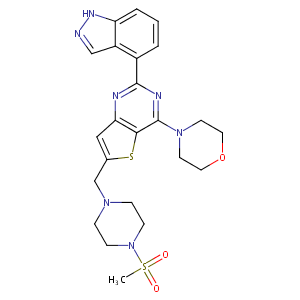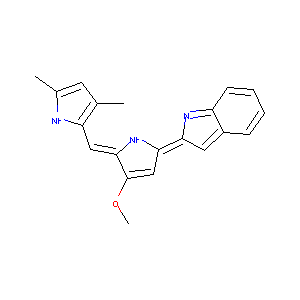| DOT Name |
DOT ID |
UniProt ID |
Mode of Action |
REF |
|
Bile salt export pump (ABCB11)
|
OTRU7THO
|
ABCBB_HUMAN
|
Decreases Activity
|
[7] |
|
Phosphatidylinositol 4,5-bisphosphate 3-kinase catalytic subunit delta isoform (PIK3CD)
|
OTOMP6TH
|
PK3CD_HUMAN
|
Decreases Activity
|
[8] |
|
Bcl-2-like protein 11 (BCL2L11)
|
OTNQQWFJ
|
B2L11_HUMAN
|
Increases Expression
|
[9] |
|
Forkhead box protein O3 (FOXO3)
|
OTHXQG4P
|
FOXO3_HUMAN
|
Decreases Phosphorylation
|
[10] |
|
L-lactate dehydrogenase A chain (LDHA)
|
OTN7K4XB
|
LDHA_HUMAN
|
Decreases Expression
|
[11] |
|
Myc proto-oncogene protein (MYC)
|
OTPV5LUK
|
MYC_HUMAN
|
Decreases Expression
|
[10] |
|
High affinity nerve growth factor receptor (NTRK1)
|
OTJORQAU
|
NTRK1_HUMAN
|
Decreases Activity
|
[8] |
|
Cellular tumor antigen p53 (TP53)
|
OTIE1VH3
|
P53_HUMAN
|
Increases Expression
|
[12] |
|
Cyclin-dependent kinase 1 (CDK1)
|
OTW1SC2N
|
CDK1_HUMAN
|
Decreases Phosphorylation
|
[13] |
|
Cathepsin B (CTSB)
|
OTP9G5QB
|
CATB_HUMAN
|
Increases Expression
|
[14] |
|
Hepatocyte growth factor receptor (MET)
|
OT7K55MU
|
MET_HUMAN
|
Increases Expression
|
[5] |
|
Poly polymerase 1 (PARP1)
|
OT310QSG
|
PARP1_HUMAN
|
Increases Cleavage
|
[15] |
|
Apoptosis regulator Bcl-2 (BCL2)
|
OT9DVHC0
|
BCL2_HUMAN
|
Decreases Expression
|
[12] |
|
Solute carrier family 2, facilitated glucose transporter member 1 (SLC2A1)
|
OTA675TJ
|
GTR1_HUMAN
|
Decreases Expression
|
[11] |
|
Lysosome-associated membrane glycoprotein 1 (LAMP1)
|
OTYE92QY
|
LAMP1_HUMAN
|
Increases Expression
|
[14] |
|
G2/mitotic-specific cyclin-B1 (CCNB1)
|
OT19S7E5
|
CCNB1_HUMAN
|
Decreases Expression
|
[13] |
|
Transcription factor EB (TFEB)
|
OTJUJJQY
|
TFEB_HUMAN
|
Increases Expression
|
[14] |
|
Receptor tyrosine-protein kinase erbB-3 (ERBB3)
|
OTRSST0A
|
ERBB3_HUMAN
|
Increases Expression
|
[5] |
|
Ribosomal protein S6 kinase beta-1 (RPS6KB1)
|
OTAELNGX
|
KS6B1_HUMAN
|
Decreases Phosphorylation
|
[16] |
|
Eukaryotic translation initiation factor 4B (EIF4B)
|
OTE8TXA8
|
IF4B_HUMAN
|
Decreases Phosphorylation
|
[12] |
|
G1/S-specific cyclin-D1 (CCND1)
|
OT8HPTKJ
|
CCND1_HUMAN
|
Decreases Expression
|
[13] |
|
G1/S-specific cyclin-E1 (CCNE1)
|
OTLD7UID
|
CCNE1_HUMAN
|
Decreases Expression
|
[12] |
|
Mitogen-activated protein kinase 3 (MAPK3)
|
OTCYKGKO
|
MK03_HUMAN
|
Increases Activity
|
[17] |
|
Mitogen-activated protein kinase 1 (MAPK1)
|
OTH85PI5
|
MK01_HUMAN
|
Increases Activity
|
[17] |
|
RAC-alpha serine/threonine-protein kinase (AKT1)
|
OT8H2YY7
|
AKT1_HUMAN
|
Decreases Phosphorylation
|
[8] |
|
Cyclin-dependent kinase inhibitor 1 (CDKN1A)
|
OTQWHCZE
|
CDN1A_HUMAN
|
Increases Expression
|
[12] |
|
Phosphatidylinositol 4,5-bisphosphate 3-kinase catalytic subunit beta isoform (PIK3CB)
|
OTO8JQJA
|
PK3CB_HUMAN
|
Affects Activity
|
[8] |
|
Serine/threonine-protein kinase mTOR (MTOR)
|
OTHH8KU7
|
MTOR_HUMAN
|
Decreases Activity
|
[18] |
|
Caspase-3 (CASP3)
|
OTIJRBE7
|
CASP3_HUMAN
|
Increases Activity
|
[19] |
|
Cyclin-dependent kinase inhibitor 1B (CDKN1B)
|
OTNY5LLZ
|
CDN1B_HUMAN
|
Increases Expression
|
[12] |
|
Phosphatidylinositol 4,5-bisphosphate 3-kinase catalytic subunit gamma isoform (PIK3CG)
|
OT3FAU4Y
|
PK3CG_HUMAN
|
Affects Activity
|
[8] |
|
Glycogen synthase kinase-3 beta (GSK3B)
|
OTL3L14B
|
GSK3B_HUMAN
|
Decreases Phosphorylation
|
[16] |
|
Caspase-9 (CASP9)
|
OTD4RFFG
|
CASP9_HUMAN
|
Increases Cleavage
|
[10] |
|
Small ribosomal subunit protein eS6 (RPS6)
|
OTT4D1LN
|
RS6_HUMAN
|
Decreases Phosphorylation
|
[15] |
|
Induced myeloid leukemia cell differentiation protein Mcl-1 (MCL1)
|
OT2YYI1A
|
MCL1_HUMAN
|
Decreases Expression
|
[5] |
|
Eukaryotic translation initiation factor 4E-binding protein 1 (EIF4EBP1)
|
OTHBQVD5
|
4EBP1_HUMAN
|
Decreases Phosphorylation
|
[20] |
|
Cyclin-G2 (CCNG2)
|
OTII38K2
|
CCNG2_HUMAN
|
Increases Expression
|
[5] |
|
Hypoxia-inducible factor 1-alpha (HIF1A)
|
OTADSC03
|
HIF1A_HUMAN
|
Decreases Expression
|
[11] |
|
Carbonic anhydrase 9 (CA9)
|
OTNA51XT
|
CAH9_HUMAN
|
Decreases Expression
|
[11] |
|
Atos homolog protein A (ATOSA)
|
OTWFM5G0
|
ATOSA_HUMAN
|
Increases Expression
|
[5] |
|
Bcl2-associated agonist of cell death (BAD)
|
OT63ERYM
|
BAD_HUMAN
|
Decreases Phosphorylation
|
[20] |
|
Proline-rich AKT1 substrate 1 (AKT1S1)
|
OT4JHN4Y
|
AKTS1_HUMAN
|
Decreases Phosphorylation
|
[21] |
|
Serine/threonine-protein kinase Sgk3 (SGK3)
|
OTQ6QO99
|
SGK3_HUMAN
|
Decreases Phosphorylation
|
[13] |
|
Phosphoinositide-3-kinase-interacting protein 1 (PIK3IP1)
|
OTWE5G4T
|
P3IP1_HUMAN
|
Increases Expression
|
[5] |
|
UDP-N-acetylglucosamine--peptide N-acetylglucosaminyltransferase 110 kDa subunit (OGT)
|
OT1Z1ZXE
|
OGT1_HUMAN
|
Increases Response To Substance
|
[22] |
|
RNA cytidine acetyltransferase (NAT10)
|
OT6JQO26
|
NAT10_HUMAN
|
Affects Response To Substance
|
[23] |
|
GTPase KRas (KRAS)
|
OT78QCN8
|
RASK_HUMAN
|
Increases Response To Substance
|
[5] |
|
Epidermal growth factor receptor (EGFR)
|
OTAPLO1S
|
EGFR_HUMAN
|
Increases Response To Substance
|
[5] |
|
ATP-dependent translocase ABCB1 (ABCB1)
|
OTEJROBO
|
MDR1_HUMAN
|
Affects Transport
|
[24] |
|
Dendrin (DDN)
|
OTM52ZF5
|
DEND_HUMAN
|
Increases Response To Substance
|
[22] |
|
Receptor tyrosine-protein kinase erbB-2 (ERBB2)
|
OTOAUNCK
|
ERBB2_HUMAN
|
Increases Response To Substance
|
[25] |
|
Phosphatidylinositol 3,4,5-trisphosphate 3-phosphatase and dual-specificity protein phosphatase PTEN (PTEN)
|
OTOWDUNT
|
PTEN_HUMAN
|
Increases Response To Substance
|
[21] |
|
Phosphatidylinositol 4,5-bisphosphate 3-kinase catalytic subunit alpha isoform (PIK3CA)
|
OTTOMI8J
|
PK3CA_HUMAN
|
Increases Response To Substance
|
[25] |
|
Pro-neuregulin-1, membrane-bound isoform (NRG1)
|
OTZO6F1X
|
NRG1_HUMAN
|
Decreases Response To Substance
|
[26] |
| ------------------------------------------------------------------------------------ |
|
|
|
|


